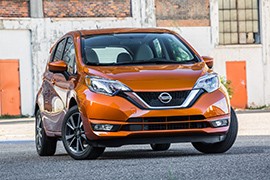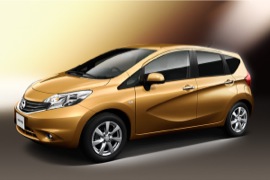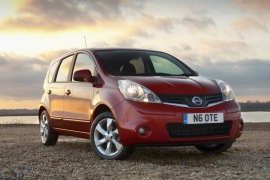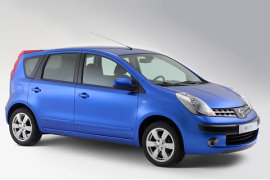NISSAN Note Models/Series Timeline, Specifications & Photos
First production year: 2005
Engines: Gasoline, Diesel
Body style: Van
Nissan introduced a second update to its small-sized MPV Note, also known as the Versa in some countries, trying to gain more money from the five-years-old vehicle.
When Nissan introduced the Versa/Note on the market based on the same platform as the Micra and the Almera, it tried to convince people that the MPV is the best solution for a small family that looks for a spacious, yet short, vehicle. It wasn't a complete success on the market, but good enough for the bean counters to keep it on the assembly lines. After the first facelift, which happened in 2014, the carmaker decided to improve it again in 2017.
Nissan already introduced the V-shaped chromed trim on most of its models, but the Note was still left with the older version. The 2017 model-year fixed that. It also sported a new front bumper, which looked sportier than before, with the lower apron and a small lip at the bottom. On the sides, the newly designed 15" or 16" alloy wheels, depending on the options, created an image of a sports-chic vehicle.
Inside, the carmaker tried to induce another sporty appearance with silver plastic trims on the dashboard, steering wheel, center console, and door handles. It also sported bigger cup holders, a new 12-volt plug, and a relocated USB port for the sound system. The upgraded infotainment unit was still placed in the middle of the center stack, between the upper air vents and the lower climate-control knobs. Like its non-facelifted version, the 2017 model-year offered a high seating position and enough room for five adult passengers.
Under the hood, Nissan installed a new, 1.6-liter powerplant mated as standard with a CVT gearbox named X-Tronic by the carmaker.
Nissan introduced the second generation of the Note MPV at the 2013 Geneva Motor Show in Europe, but sales started later that year.
Built on top of the same B-segment platform used on the Micra, the Note's second generation tried to provide more room and comfort in a shorter vehicle. In addition, unlike its predecessor, the second generation came with a better look, which made it stand out from the crowd. Unfortunately, the small-segment MPV was not popular in many countries, and that was the last generation of the Note.
Unlike its predecessor, which had bland styling, the Note's second generation came with a V-shaped front fascia and swept-back headlights. In addition, the lower bumper received an A-shaped grille flanked by optional fog lamps. From its sides, the sculptured doors formed another dynamically looking element resembling a Japanese sword's tip. Finally, at the back, the tailgate was flanked by a pair of taillights with a complicated design that blended sharp angles and arched lines.
The cabin was roomy for four passengers, and even a fifth one could sit in the back on the split-folding bench. At the front, the driver and side passenger sat on high-mounted seats fronting a dashboard designed with waved shapes at the top. In addition, the center stack could've been optioned with an infotainment system that featured a touchscreen and navigation.
Under the hood, the Note received a choice of three engines, either gasoline or turbo-diesel, depending on the market. A CVT gearbox was available for the top-spec gasoline unit.
After two years on the market, Nissan improved the Note MPV to comply with the Euro5 regulations, leading to lower CO2 emissions.
Nissan made the Note to compete in the compact segment with a small-sized MPV, thus offering it at a lower price on the market, but the result was a car that was hard to sell. Moreover, the world financial crisis affected the carmaker's income.
Nissan noticed that the customers were not impressed by the Note's appearance and extensively worked on that area. Thus, the grille was reworked and sported two parallel slats that met in the middle, supporting the carmaker's badge. It also added a chromed trim at the bottom, just above the bumper. Moreover, the new headlights with clear lenses looked fresh. At the same time, the extended apron with a broad air intake improved the cooling area.
Inside, the most important upgrade was for the infotainment system, where the carmaker decided to install the Nissan Connect unit, which included the navigation and an HDD for storing MP3s. Even though the screen was small, it provided enough information for the driver. In addition, depending on the trim levels, the Note received better interior materials.
On the technical side, the carmaker softened the suspension settings, thus improving the comfort. Even though it claimed that it also improved the handling, that was true mostly on uneven surfaces. There were four engine choices, but only the 1.6-liter gasoline unit was available with a CVT, while the new, Renault-sourced turbodiesel powerplants were offered with a standard six-speed manual.
The Renault-Nissan Alliance produced some great vehicles, such as the Altima and the revival of the GTR. But the money to build those were made by trials and errors. Such as the Nissan Note.
After the two car-makers started to work together, the Japanese company had to admit that they were not as good in making small cars as their French partners. But their kei-car obsession was transformed into a small MPV named Note and based on a jointly developed platform. In 2004, the Note hit the market. And the market hit back.
Tall, narrow, and long, the Note excelled in transporting five adults into a small-size vehicle that was easy to drive, easy to park, and handled well in the city. But the styling was not its main attribute. The swept-back headlights, the short hood, and the tall greenhouse didn't arouse the European appetite. On the front, a tall bumper and narrow grille were installed. They said it will be good against parking trade-paints. The vertical rear end helped the driver, but the overall look of the car resembled a utility vehicle more than a family car.
Inside, there was enough room for five adults. Three seats in the back with more than enough legroom and headroom. Isofix child-seat mounting points and safety belts for everyone aboard were welcomed from the safety point of view. The sliding rear bench made possible trade for luggage or for legroom. For long trips, the glove-box was refrigerated and could hold up to 13 cans of beverages.
Nissan Note was offered with a choice of four engines mated to a 5-speed manual, plus another version mated to a CVT. But the sales didn't go well and the small MPV was discontinued in 2013.



